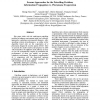Free Online Productivity Tools
i2Speak
i2Symbol
i2OCR
iTex2Img
iWeb2Print
iWeb2Shot
i2Type
iPdf2Split
iPdf2Merge
i2Bopomofo
i2Arabic
i2Style
i2Image
i2PDF
iLatex2Rtf
Sci2ools
101
Voted
ICTAI
2007
IEEE
2007
IEEE
Swarm Approaches for the Patrolling Problem, Information Propagation vs. Pheromone Evaporation
This paper deals with the multi-agent patrolling problem in unknown environment using two collective approaches exploiting environmental dynamics. After specifying criteria of performances, we define a first algorithm based only on the evaporation of a pheromone dropped by reactive agents (EVAP). Then we present the model CLInG [10] proposed in 2003 which introduces the diffusion of the idleness of areas to visit. We systematically compare by simulations the performances of these two models on growingcomplexity environments. The analysis is supplemented by a comparison with the theoretical optimum performances, allowing to identify topologies for which methods are the most adapted.
Artificial Intelligence | ICTAI 2007 | Multi-agent Patrolling Problem | Theoretical Optimum Performances | Unknown Environment |
| Added | 03 Jun 2010 |
| Updated | 03 Jun 2010 |
| Type | Conference |
| Year | 2007 |
| Where | ICTAI |
| Authors | Hoang Nam Chu, Arnaud Glad, Olivier Simonin, François Sempé, Alexis Drogoul, François Charpillet |
Comments (0)

